Team:TU-Munich/HumanPractice/Media
From 2013.igem.org
Deutsches Museum Munich
We had the chance to introduce the Physco Filter and our iGEM team to the public at the visitors lab at the German Museum of Munich. Green biotechnology is perceived rather negatively in Germany, but the majority of expressed concers relates to applications in agriculture and food. So in addition to presenting our project and answering a lot of interested questions about sythetic biology, we asked people about their views to see if projects like the Physco Filter can bring a different perspective into the public debate about biotechnology.
Because of the Octoberfest, we had a large and very international audience with whom we had very interesting discussions. We had prepared a poster aimed at a larger audience in German language, but we could have needed posters in English, Italian, French, Russian, Chinese and Hebrew as well and had the chance to use all the forgein language skills we had. The feedback we received was much more positive than expected. People complimented our idea and considered this application of green biotechnology as much more feasible due to its thorough biosafety profile.
We really enjoyed this campaign because of all the valuable feedback and the large diversity of input we got. It was very inspiring to meet and talk to all those people and once again, our iGEM activities enriched our views.
PhyscoFilter presentation at the German Museum
Survey on the public perception of biotechnology
The public perception of biotechnology in Germany is traditionally not very positive. But how much do people know about sythetic biology and are red, white and green biotechnology perceived equally postive or negative? On iGEM day Germany, we set out to inform, explain and investigate. How much impact does the pollution of water through pharmaceuticals and hormones have on people´s private life as well as globally according to public opinion? And would projects like our Physco Filter that adresses these problems increase the acceptance of sythetic biology or not? Would people want to use our filter or support its use in public sewage plants? Here is what we found out:
Auswertung Umfrage
Images from our information booth in the city of Freising
13th Munich Science Days
http://www.muenchner-wissenschaftstage.de/2013/front_content.php
Media coverage on iGEM 2013 project
TUM WZW News (german)
[1] (german)
"A gateway to a lot of Synthetic Biology" - The part about our last years iGEM project is from minute 14.20 on. An interesting video from the beginning to the end by the way.
[2] (german)
Introducing Synthetic Biology Kits at School
Introduction
It is the first time for a TU Munich iGEM team to prepare „School-Kits“, to make it possible for disciples to take the first steps in Synthetic Biology. The idea is to send a kit with all required reagents and lab-protocols, based on the experiments we designed, to educational institutions which are interested in inspiring young prospective people who are planning a career in science. Our experiments are designed in an easy way, so every disciple, independent of training level, is able to understand and take notice of the resulting phenomena which Synthetic Biology makes possible.
The School-kit
The reagents, which are necessary for the realization of the experiments are all found in the kit, except for competent cells, which have to be stored at -20°C. The kit includes the following reagents:
| Reagent | Amount of the Reagent | Is it existent in the kit? |
|---|---|---|
| LB-Medium | Reagents for about 3 L are in the kit | Yes |
| "Banana-Odor"-Plasmid | 100 µl (10 ng/µl) | Yes |
| "RFP-Generator"-Plasmid | 100 µl (10 ng/µl) | Yes |
| "Luciferase"-Plasmid | 100 µl (10 ng/µl) | Yes |
| Isoamylalcohol (>98 %) | 10 ml | Yes |
| Agar plates (Resistance: Kanamycin) | 4 Plates | Yes |
| Agar plates (Resistance: Chloramphenicol) | 2 | Yes |
| L-Arabinose (500 mM) | 3.76 g (50 ml) | Yes |
| Kanamycin | 25 ml | Yes |
| Chloramphenicol | 25 ml | Yes |
| Competent Cells | 6 Tubes (Aliquotvolume: 150 µl) | No |
As you may have noticed, we provide three different plasmids, which are used seperately in each designed experiment. The aim of the experiments is to perform the whole way from transformation, over cultivating cells, inducing the production of proteins and in the end demonstrate the conversion of a substrate by the produced enzyme.
Experiment Number 1
The aim of the first experiment is to transform the "RFP-Generator"-Plasmid into Escherichia coli containing genes coding for Chloramphenicol resistance and a red fluorophor and to plate them on Chloramphenicol-Agarplates. The Agarplates, provided with the antibiotica Chloramphenicol, make a selection process possible, whose aim is to kill all bacteria which have not incorporated the "RFP-Generator"-Plasmid. The expression rate of the red fluorophor is controlled by a constitutive promotor, so the Red fluorescent Protein is expressed continuously. After just about one day of incubation time, the disciples are able to notice a change in colour of the bacteria from ocher to red.
Experiment Number 2
In the second experiment disciples should perform the transformation, learned in experiment one, with the "Luciferase"-Plasmid which encodes genes for Kanamycin resistance and a protein-fluorophor called Nanoluciferase. Another very important point is that the Nanoluciferasegene is subordinated to a L-Arabinose Operon. After the transformation of the DNA-Plasmid has taken place, discicples should learn how to cultivate bacteria in liquid LB-Medium and how to induce protein expression by using L-Arabinose as an inductor of the L-Arabinose promotor. The glow of the nanoluciferase can be observed after just a couple of hours.
Experiment Number 3
In the third experiment, all aspects learned in the previous experiments come together. They are necessary to understand the following approaches. The "Banana-Odor"-Plasmid encodes an enzyme called Alcohol-Acetyltransferase I. This enzyme is able to convers Isoamylalcohol into Isoamylacetat, which spreads the odor of banana. Additionally there is found a resistance gene for Kanamycin and an inducible L-Arabinose promotor, which controls the expressions rate of the Alcohol-Acetyltransferase I. The disciples should transform the "Banana-Odor"-Plasmid into Escherichia coli, cultivate the successfully transformed bacteria in a bigger scale and in the end, induce the protein expression using L-Arabinose. In the last step, the disciples should add the substrate Isoamylalcohol to the cell culture, so the produced enzyme can transform it into Isoamylacetat.
Target Audience
Our target audience have been secondary schools, which focus a biotechnical educational pathway, so all students have access to the required laboratory equipment for the experiments. Before sending the kits to the schools, we tested them in detail - with success. All schools we contacted, to spread our Synthetic Biology kits, are very enthusiastic concerning our idea of supporting young prospective scientists, so they are very excited to receive and use our kit!
Availability of the School-kit
We appreciate other interested schools in trying our “School kits”. Do not be ashamed of contacting us, so we can supply you with our forward-looking Synthetic Biology “School-kit”!
Media coverage on iGEM 2012 project after the Jamboree
An article in the BeerAdvocate magazine #72 written by Aleszu Bajak.
"A gateway to a lot of Synthetic Biology" - The part about our last years iGEM project is from minute 14.20 on. An interesting video from the beginning to the end by the way.
References
- [Edens et al., 1984] Edens, L., Bom, I., Ledeboer, A. M., Maat, J., Toonen, M. Y., Visser, C., and Verrips, C. T. (1984). Synthesis and processing of the plant protein thaumatin in yeast. Cell, 37(2):629–33.
 "
"



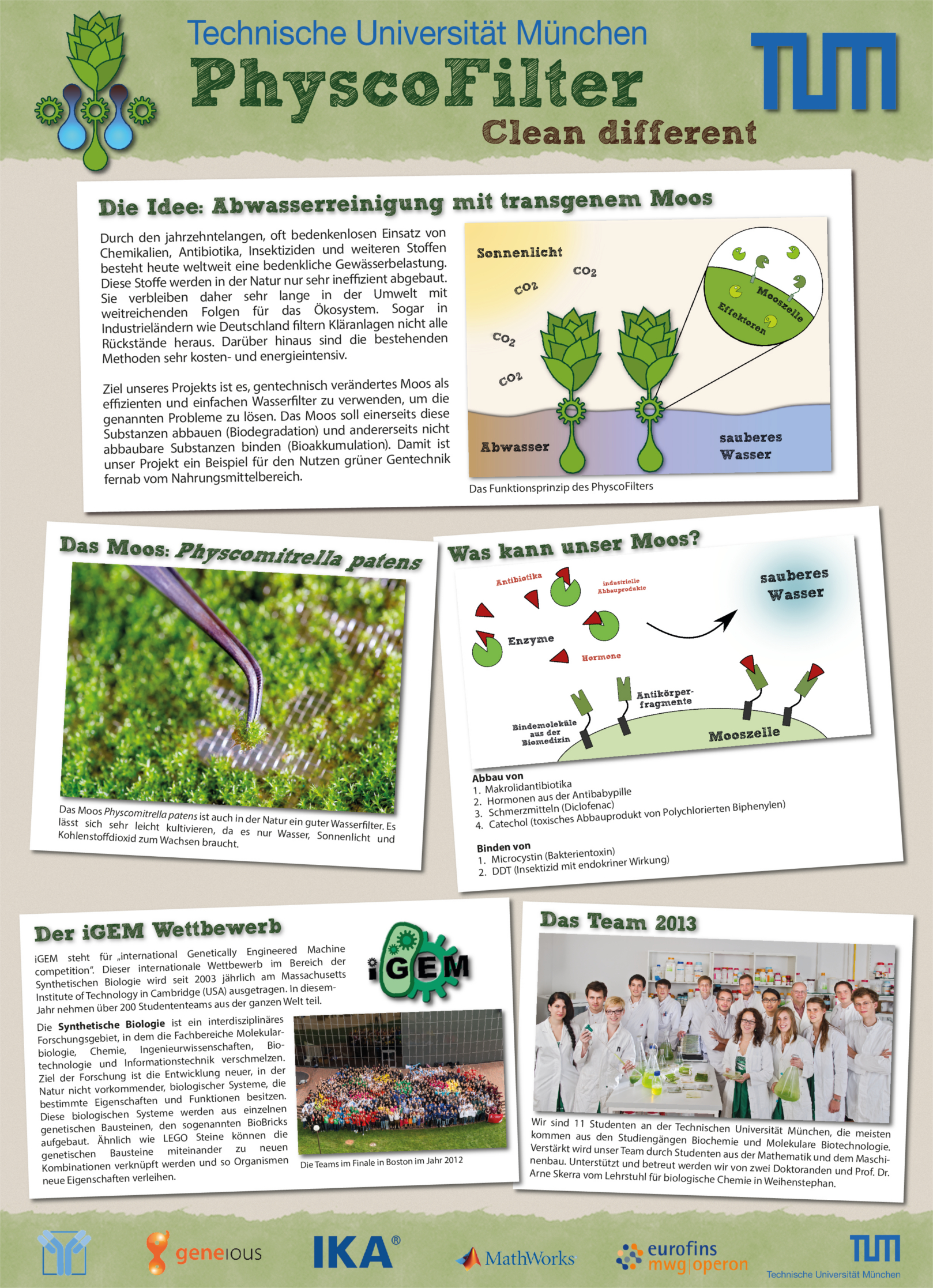


























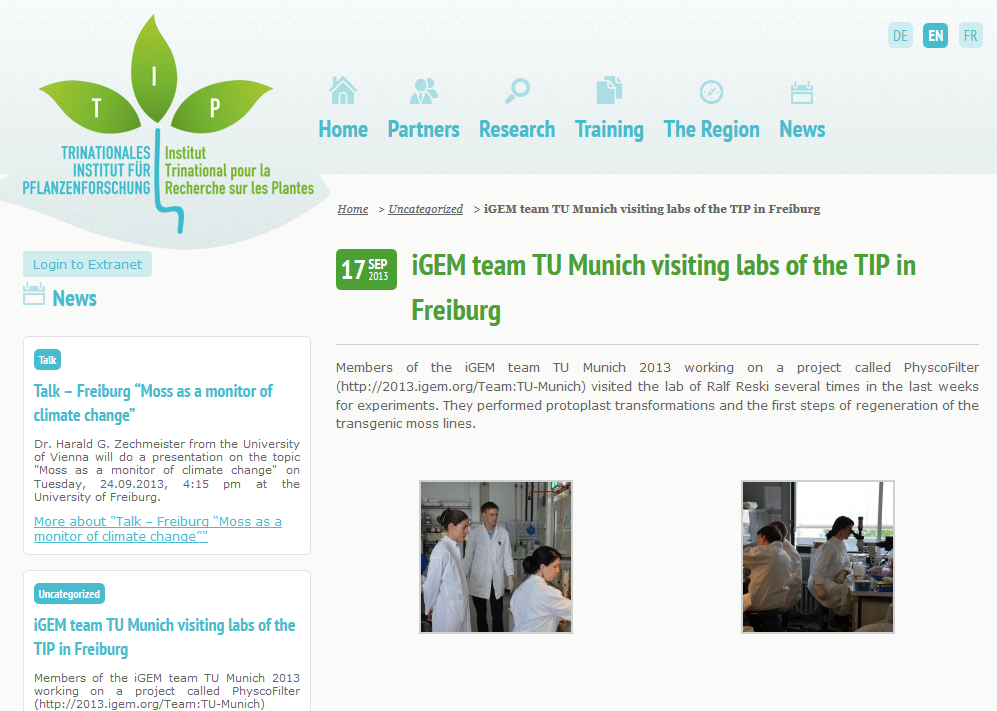
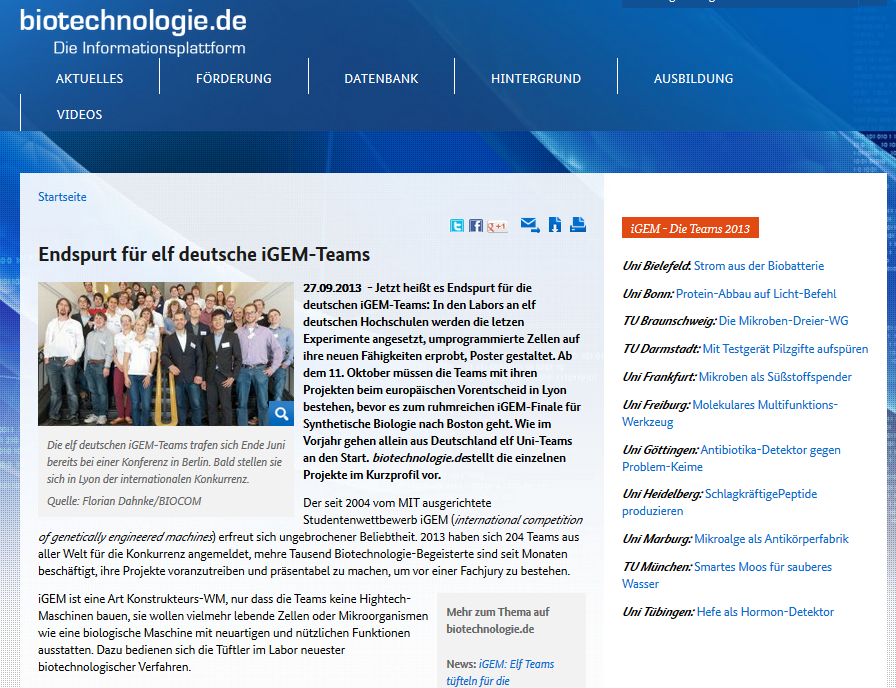

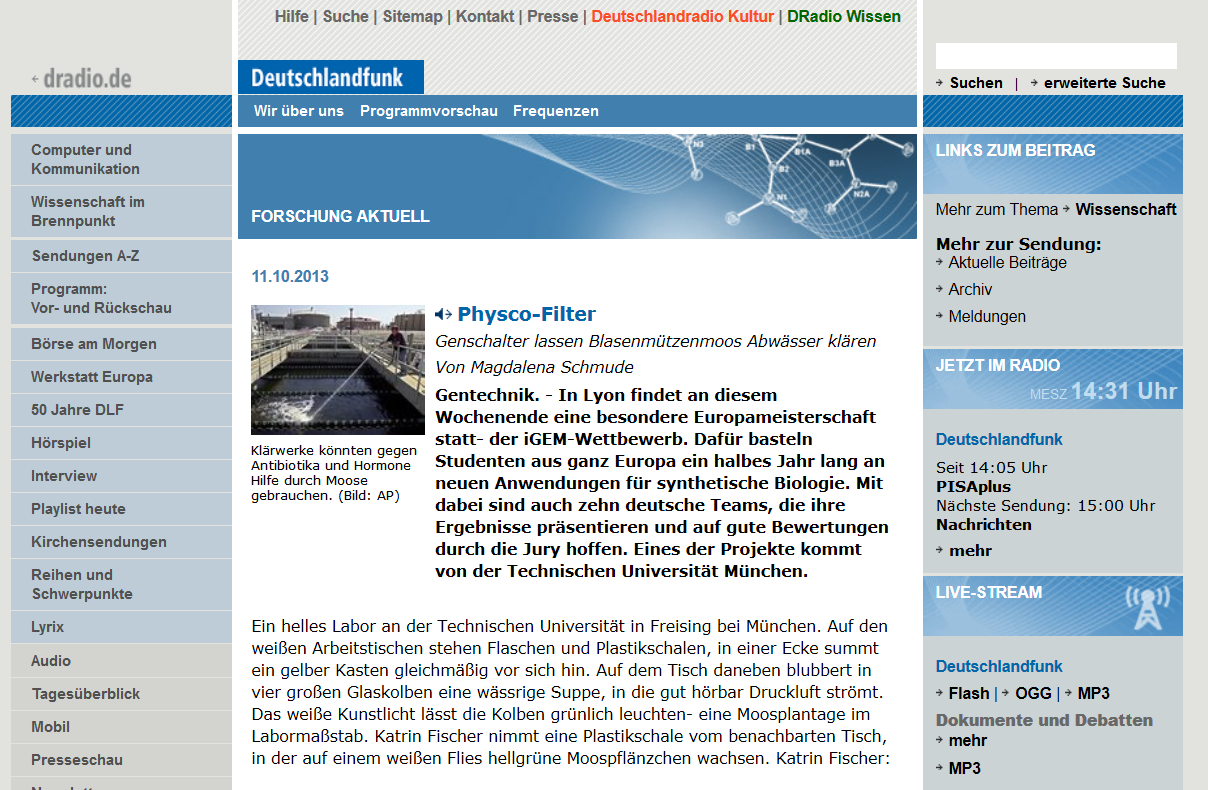

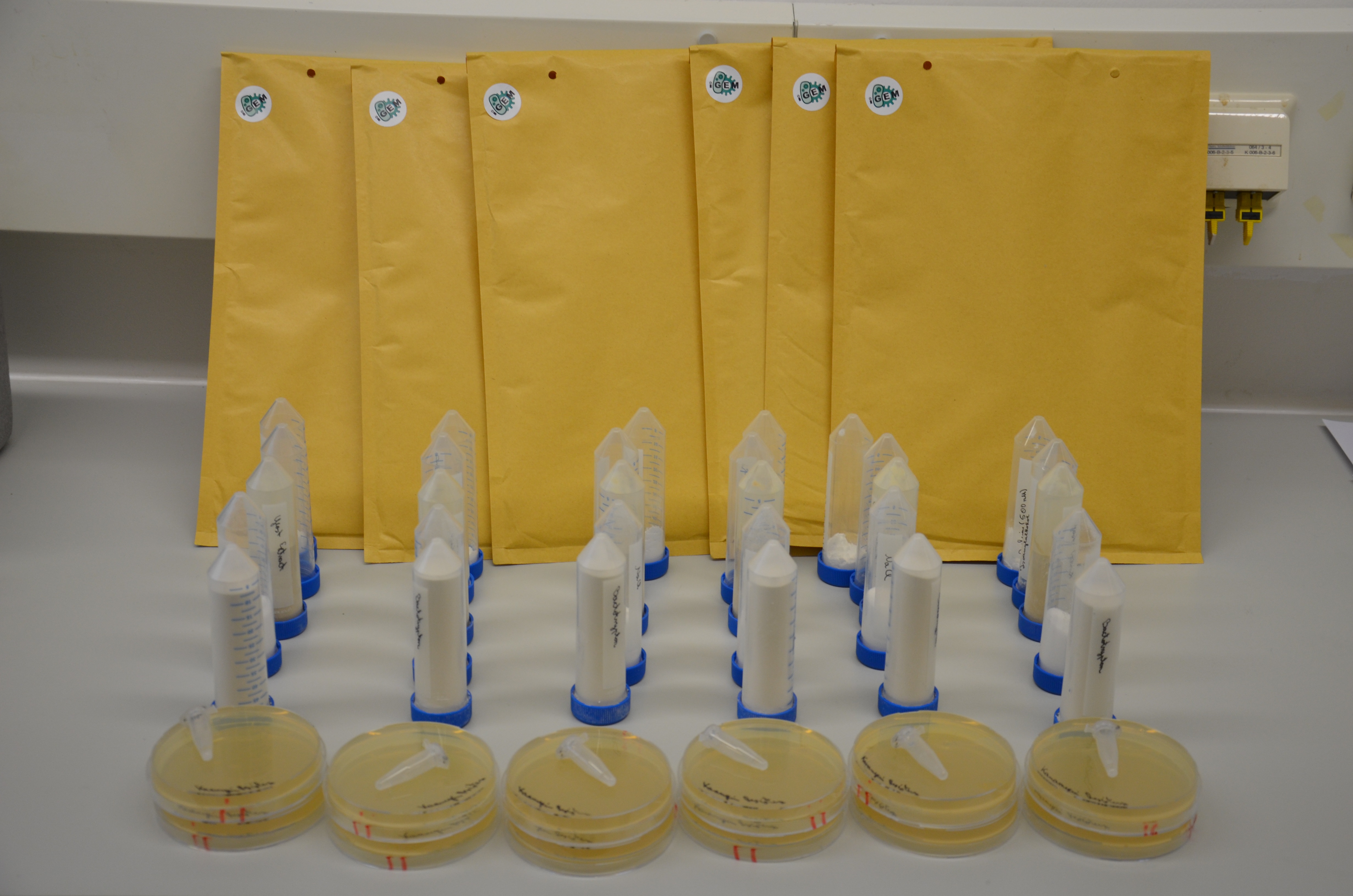


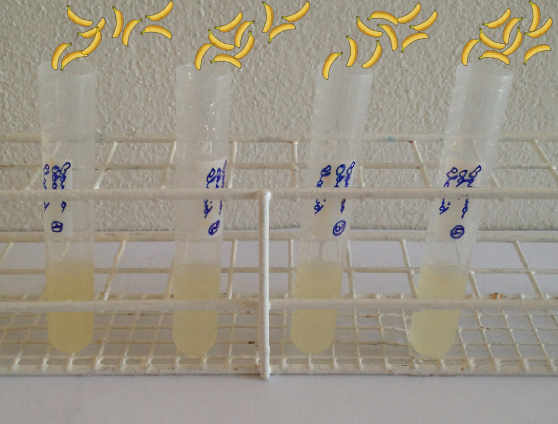
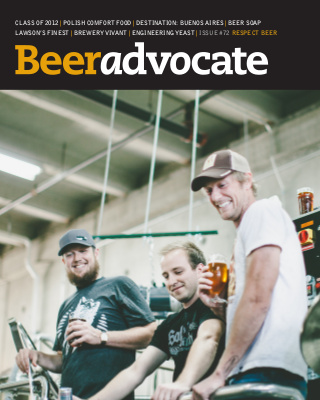
AutoAnnotator:
Follow us:
Address:
iGEM Team TU-Munich
Emil-Erlenmeyer-Forum 5
85354 Freising, Germany
Email: igem@wzw.tum.de
Phone: +49 8161 71-4351